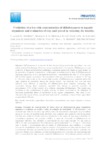Please use this identifier to cite or link to this item:
http://www.alice.cnptia.embrapa.br/alice/handle/doc/1056417| Title: | Prediction of a low-risk concentration of diflubenzuron to aquatic organisms and evaluation of clay and gravel in reducing the toxicity. |
| Authors: | JONSSON, C. M.  SILVA, M. S. G. M. e   MACEDO, V. S. de   DANTZGER, D. D.   VALLIM, J. H.   MARIGO, A. L. S.   AOYAMA, H.   |
| Affiliation: | CLAUDIO MARTIN JONSSON, CNPMA; MARIANA SILVEIRA GUERRA MOURA E SIL, CNPMA; VINICIUS SILVA DE MACEDO, Colégio Técnico de Campinas da Unicamp; DARLENE DENISE DANTZGER, IB-UNICAMP; JOSE HENRIQUE VALLIM, CNPMA; ANA LUCIA SILVA MARIGO, CNPMA; HIROSHI AOYAMA, IB-UNICAMP. |
| Date Issued: | 2015 |
| Citation: | Pan-American Journal of Aquatic Sciences, [S.l.], v. 10, n. 4, p. 259-272, 2015. |
| Description: | Resumo: Predição da concentração de baixo risco de diflubenzuron para organismos aquáticos e avaliação da argila e brita na redução da toxicidade. O diflubenzuron é um inseticida que além de ser usado agricultura, tem sido amplamente empregado na piscicultura, apesar do seu uso ser proibido nesta atividade. Este composto não consta na lista da legislação brasileira que estabelece limites máximos permissíveis em corpos de água para a proteção das comunidades aquáticas. No presente trabalho, a partir da toxicidade do diflubenzuron em organismos não-alvo, foi calculada a concentração de risco para somente 5% das espécies (HC5). O valor deste parâmetro foi estimado em aproximadamente 7 x 10-6 mg L-1 . Este baixo valor é devido à extremamente alta toxicidade do diflubenzuron para dafnídeos e à grande variação de sensibilidade entre as espécies testadas. Dois matérias de relativamente baixo custo se mostraram eficientes na remoção da toxicidade do diflubenzuron de soluções contendo este composto. Dentre esses materiais, a argila expandida promoveu a redução em aproximadamente 50% da toxicidade de uma solução contendo diflubenzuron. Os resultados podem contribuir para políticas públicas no Brasil relacionadas ao estabelecimento de limites máximos permissíveis de xenobióticos no compartimento aquático. Também, para a pesquisa de matérias inertes e de baixo custo com potencial de remoção de xenobióticos presentes em efluentes da aquicultura ou da agricultura. Abstract: Diflubenzuron is an insecticide that, besides being used in the agriculture, has been widely used in fish farming. However, its use is prohibited in this activity. Diflubenzuron is not in the list of Brazilian legislation establishing maximum permissible limits in water bodies for the protection of aquatic communities. In this paper, according toxicity data of diflubenzuron in non-target organisms, it was calculated an hazardous concentration for only 5% of the species (HC5) of the aquatic community. This parameter value was estimated to be about 7 x 10 -6 mg L -1 . The low value is due to the extreme high toxicity of diflubenzuron to daphnids and to the large variation in sensitivity among the species tested. Two relatively low cost and inert materials were efficient in removing the diflubenzuron from solutions containing this compound. Among these materials, expanded clay shown to promote reduction of approximately 50% of the toxicity of a solution containing diflubenzuron. The results may contribute to the establishment of public policies in Brazil associated to the definition of maximum permissible limits of xenobiotics in the aquatic compartment. This study is also relevant to the search of low cost and inert materials for xenobiotics removal from aquaculture or agricultural effluents. |
| Thesagro: | Inseticida Poluiçao da água Argila Organismo aquático Impacto ambiental Aquicultura |
| NAL Thesaurus: | Aquatic environment Water pollution Insecticides Diflubenzuron Risk assessment Water purification |
| Keywords: | Concentração de risco Organismos não-alvo Despoluição Brita |
| Type of Material: | Artigo de periódico |
| Access: | openAccess |
| Appears in Collections: | Artigo em periódico indexado (CNPMA)  |
Files in This Item:
| File | Description | Size | Format | |
|---|---|---|---|---|
| 2016AP08.pdf | 293,08 kB | Adobe PDF |  View/Open |









